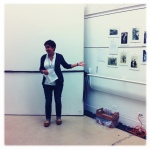TAG Berkeley Show
Last month I participated in “Opening Dialogs in Archaeological Photography” at the USA 2011 edition of TAG held at UC Berkeley in sunny California. The session, organised by Heather Law, consisted of an exhibition of the work of 11 archaeologist photographers and an afternoon session of “dialogues” with those involved.
I aim to post the work of all 11 participants on this site over the next couple of months, so this post is here to give you a flavour of the show overall and give you some of my personal impressions of the session.
Overall the dialogues were incredibly successful and very positive. The crowd found something good to say about the all of the contributions. The incredibly varied contributions ranged from documentary, artistic and journalistic styles through conceptual (or perhaps phenomenological) photography to found photography. Unsurprisingly, none of the contributions fitted particularly neatly into any one of these photographic genres; all could be taken to illustrate a vast range of archaeological themes.
The show and the dialogues were, in my experience, unique as a format for a conference session. Heather’s choice of removing the chairs from the gallery meant that the session was conducted on foot, with the group moving around the gallery to face the work being discussed. Each photographer stood in front of their work to make their presentation and answer questions. Colleen Morgan has already blogged about the way in which the gallery format gave the session a quite distinct feel from a standard conference session. For me, the physical movement of the participants around the room made the session (literally) more dynamic in nature than any session I have ever taken part in.
The “art gallery” as an appropriate space to exhibit art work has been the subject of lengthy and ongoing debate in the context of contemporary art. In some ways our exhibition within an art gallery stumbled into this debate. Our work definitely became modified by its transposition into a white cube, casting off some of it’s purely archaeological and academic overtones and pulling on a series of new and unexpected meanings. The idea that anything can become art because of an artist’s choice or by inclusion in an art gallery was particularly pertinent to the contributions that consisted of found photographs and vernacular photographs.
I felt that the dialogues may have lacked teeth somewhat. When compared to the harsher kind of criticism that would be expected at an art school “crit” for example, the session was pretty tame. None of the participants left the room in tears or swearing that they would never pick up another camera ever again, put it like that. The intimate setting of the dialogues was very enjoyable, but it may have prevented less reserved and more critical responses coming out.
- by Colleen Morgan
- by Colleen Morgan
- by Colleen Morgan
About this entry
You’re currently reading “TAG Berkeley Show,” an entry on Archaeologists | Photographers
- Published:
- May 31, 2011 / 8:32 pm
- Category:
- Exhibition
- Tags:




No comments yet
Jump to comment form | comment rss [?] | trackback uri [?]